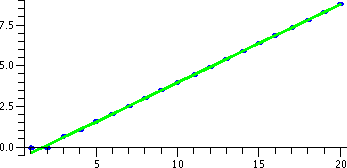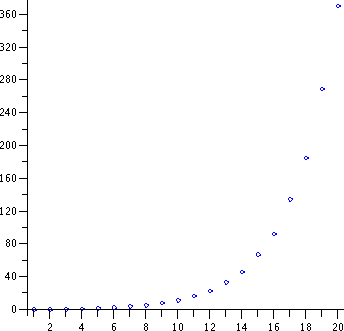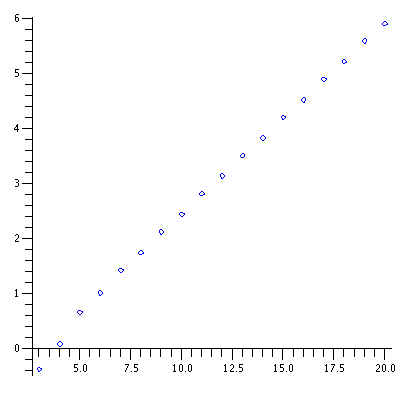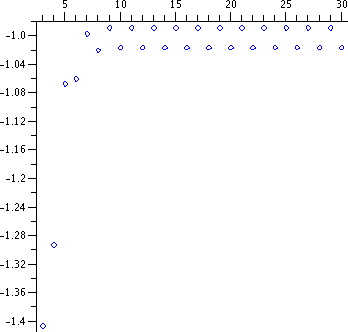Diary for 01:090:101:21, Experimental Math, fall 2008
The
sixth meeting, 10/13/2008
I hoped that representatives of other question teams will report on
their results, and indeed, I happily give thanks to Mr. Zimmerman of the Toad Team for explaning
a solution to question #4, and to Mr. Weiner of the Horse Team for explaining a
solution to question #5.
I will continue to consider recursively defined
sequences, but with a rather different perspective. We will look at
numerical approximations, not exact formulas, and end up with some
analysis of a non-linear recursive sequence, that is, one where there
are powers greater than 1.
Fibonacci, again
fibon:=proc(n) option remember; if n<=2 then 1 else fibon(n-1)+fibon(n-2) end if end proc;
The phrase option remember; may be new
to you. This is an instruction which asks Maple to store old values
which have been computed. For a recursively defined function, this can
be a big saving of time and space. On my home PC, computing
fibon(10000) with this definition took about a tenth of a second. But
then the next Fibonacci number, fibon(10001), took less than .001
seconds because the old values were saved. When doing recursion, such
economies can be significant. Without the option remember phrase, computing fibon(25)
took about .2 seconds, computing fibon(30) took 3 seconds, and
computing fibon(35) took about 32 seconds. Each increase of 5 seemed
to multiply the time needed by 10! I didn't want to wait for
fibon(100). I don't even want to think about fibon(10000) computed
this way, because the glaciers would return several times while it was
computed.
I recalled our previous results, which included the following: if we
defined the growth constants and coefficients correctly, then we can
get a formula for the Fibonacci numbers.
> gr1 :=(1+sqrt(5))/2; gr2 :=(1-sqrt(5))/2;
> A := sqrt(5)/5; B := -sqrt(5)/5;
> v := n -> A*gr1^n + B*gr2^n
Then v(n) is the same as fibon(n). But I wanted to consider some
numerical aspects of this formula. It turns out that Maple needs to be
encouraged to evaluate things numerically. Its native method is to
consider algebraic behavior. Look at these commands.
> tan(log(sin(2)));
tan(ln(sin(2)))
> tan(log(sin(2.)));
-0.09537061787
> tan(log(sin(evalf(2))));
-0.09537061787
So we can get numerical values by entering an argument with a decimal
point (this is called a floating point number) or we can use
the instruction evalf which tells Maple
to convert the argument into a floating point number. Let me
try this with the numbers we got for the Fibonacci sequence.
> f1 := evalf(gr1); f2 := evalf(gr2);
f1 := 1.618033988
f2 := -0.6180339880
> fA := evalf(A); fB := evalf(B);
fA := 0.4472135954
fB := -0.4472135954
> vf := n > fA*f1^n+fB*f2^n;
n n
vf := n -> fA f1 + fB f2
> vf(n);
n n
0.4472135954 1.618033988 - 0.4472135954 (-0.6180339880)
> vf(10)
54.99999973
There is good agreement between the real value of fibon(10), which is
55, and this value predicted by the formula. In fact, we can do
better. The contribution to the formula from the f2 term is really small when n is large. This is
because |f2|<1 and high powers of numbers with absolute values less
than 1 get small very fast. Look:
> vfbig := n -> fA*f1^n;
n
vfbig := n -> fA f1
> vfbig(10)
55.00363585
The simpler vfbig formula is quite close to 55 when n=10. This formula
is simpler and easier to compute.
Then I tried to see the evidence of closeness by creating a graph. But
powers grow quickly (at least powers of numbers larger than 1). So a
way to tame the powers is to use logs. Since log(AB)=Blog(A), the n's
in the exponent become multipliers, and something like 37n
will be n·log(37). When graphed as a function of n, this is a
straight line. Let's see what happens. I will try to comment on each
command. I won't bother to show the output until the final graph.
| Command | What's going on? | |
|---|
|
A:=seq([n,log(evalf(fibon(n)))],n=1..20);
|
| |
This creates a collection of pairs of numbers. The second element of
each pair is the log of the nth Fibonacci number.
|
|
plot({A},style=point);
| |
| |
This plots the points (the curly brackets are needed to keep Maple
happy). Think of this as "experimental data". This is part of what is
shown in the accompanying graph.
|
|
B:=seq([n,log(vfbig(n))],n=1..20);
| |
| |
Here are numbers created with a formula. We want to "see" how
closely they match the experimental data.
|
|
plot({B}); | |
| |
This generates a "curve" (really a straight line!) connecting the
formula's points. |
|
with(plots):
| |
| |
This command loads a package which has lots of elaborate plotting
programs. In particular one of its commands will allow us to display
two plots together on the same axes. |
pA:=plot({A},color=blue,thickness=2,style=point);
pB:=plot({B},color=green,thickness=2);
| |
| |
This creates two
plots, and assigns them to the names pA and pB. |
|
display({pA,pB});
| |
| |
The display command tries to show both of the pA and pB graphs together. The graph which was created with this sequence of commands is shown to the right. |
 This is
pretty good agreement of a prediction by the formula. In this case,
the "data" are the Fibonacci numbers, and the candidate for the predicting
formula is vfbig. This is
pretty good agreement of a prediction by the formula. In this case,
the "data" are the Fibonacci numbers, and the candidate for the predicting
formula is vfbig.
In the graph to the right, the "true" values of the Fibonacci numbers
are shown as blue points, and the green line which matches them fairly
closely is the approximation gotten by taking the formula which only
uses the bigger growth constant.
Remember that we used log(AB)=Blog(A) so that the formula
vfbig(n)=0.4472135954(1.618033988)n changed to log( 0.4472135954)+(1.618033988)n)
which is -0.8047189564+(0.4812118246)n, a straight line. The slope
is about 1/2: check with the picture, please.
|
|
Something more strange ...
Now let's try something (maybe) more interesting.
> qfib:=proc(n) option remember; if n<=2 then 1 else qfib(n-1)+qfib(n-2)^2 end if end proc;
This recurrence is sort of the same as the Fibonacci rule, except that
the "older" term, at n-2, is squared. I looked at this about 10 years ago, because I wanted to play and not work.
Here are a few terms. The option
remember is very valuable in this case, because the terms
get very big very fast. Look:
> seq(qfib(n),n=1..20);
1, 1, 2, 3, 7, 16, 65, 321, 4546, 107587, 20773703, 11595736272, 431558332068481, 134461531248108526465,
186242594112190847520182173826, 18079903385772308300945867582153787570051,
34686303861638264961101080464895364211215702792496667048327,
326882906438860977154700726416259589991324369642278784888886456292858687899190928,
1203139675581901612090570226442112857286846629264360460858253297925243660821490254528135651541164200107720542452689857, 106852\
43452191713927725532729169455375269635012985468141090948568014383760138473439189515451932815803934664945833959351807102464428\
8785133742254989047939450191041
| These are really big numbers. For example,
qfib(20) has 161 digits (a silicon friend assured me of this).
So we can take logs and graph. Here are some commands.
> QA:=seq([n,log(evalf(qfib(n)))],n=1..20):
> plot({QA},style=point,color=blue);
Taking logarithms of the qfib numbers makes them smaller, but not that
much smaller. They still seem to grow, and not along a straight
line! What could we do?
|  |
We could take another log, and see if that gets things under control,
and if the resulting numbers seem more predictable. Here we go:
> Al2:=seq([n,log(log(evalf(qfib(n))))],n=1..30);
Al2 := [1, Float(-infinity)], [2, Float(-infinity)], [3, -0.3665129205], [4, 0.09404782792], [5, 0.6657298105], [6, 1.019781440],
[7, 1.428967586], [8, 1.752921811], [9, 2.130847686], [10, 2.449802228], [11, 2.824303087], [12, 3.143026788], [13, 3.517451065],
[14, 3.836174038], [15, 4.210598245], [16, 4.529321218], [17, 4.903745426], [18, 5.222468399], [19, 5.596892606], [20, 5.915615580],
[21, 6.290039787], [22, 6.608762760], [23, 6.983186968], [24, 7.301909940], [25, 7.676334148], [26, 7.995057121], [27, 8.369481329],
[28, 8.688204302], [29, 9.062628509], [30, 9.381351482]
The first two numbers are weird, because log of 0 is not defined. So I
will restrict n, and make it at least 3 in all further
computations. In particular, my seq
command will have n=3..30.

Now we can plot things, and so the result of the command plot({Al2},style=point,color=blue) is shown to the
right.
What sorts of formulas would give us straight lines with log-log
computation? Well, suppose you have A(BC). Then log of this brings "down" the
exponent, and we have BC multiplied by log(A), that is,
log(A)(BC). Then
log again. The result is log(log(A))+Clog(B). So if the resulting
graph is a straight line, than C must be the variable, n, and A and B
must be constants.
I would rather not lie to you. I didn't see things this clearly a
decade ago. I think what I did was mess around with numbers. First, I
looked at log(log(evalf(qfib(n)))). Here are some numbers:
> seq(log(log(evalf(qfib(n)))),n=3..20);
-0.3665129205, 0.09404782792, 0.6657298105, 1.019781440, 1.428967586, 1.752921811, 2.130847686, 2.449802228, 2.824303087, 3.143026788,
3.517451065, 3.836174038, 4.210598245, 4.529321218, 4.903745426, 5.222468399, 5.596892606, 5.915615580
This didn't give me much insight. So I looked for how these numbers
changed – that is, I wanted to understand the slope of the "line"
that seemed to appear.
> seq(log(log(evalf(qfib(n))))-log(log(evalf(qfib(n-1)))),n=4..30);
0.4605607484, 0.5716819826, 0.3540516295, 0.409186146, 0.323954225, 0.377925875, 0.318954542, 0.374500859, 0.318723701, 0.374424277,
0.318722973, 0.374424207, 0.318722973, 0.374424208, 0.318722973, 0.374424207, 0.318722974, 0.374424207, 0.318722973, 0.374424208,
0.318722972, 0.374424208, 0.318722973, 0.374424208, 0.318722973, 0.374424207, 0.318722973
These are strange numbers. But they seem to be alternating, if you
look at them a bit. They alternate (I'll look just at the last pair)
between 0.374424207 and 0.318722973. What are these numbers? Well, it
turns out there is a wonderful web page called the Inverse
Symbolic Calculator which tries to identify numbers for you. The
ISC can't identify these numbers, but their sum is 0.6931471 which the
ISC guesses is an approximation for log(2) which you may know it as
ln(2) and half of this by properties of logs is ln(sqrt(2)). This
isn't what I actually did because I wasn't this clever. I just looked
at the numbers, and then I guessed that the average "rate of
change" or slope was log(2)/2 between integers because 0.6931471
looked familiar (the virtues of being a math nerd).
This means that log(log(evalf(qfib(n)))) should be approximately
(1/2)*log(2)n. So let's look at what remains. Remember, if the
original numbers are
A(Bn) then what we are looking at is
log(log(A))+log(B)n. If I want to see what else is there, I should
take the log-log numbers and subtract{log(2)/2}n. I am assuming
that log(B) is log(2)/2 which is log(sqrt(2)). Here are some
commands which can be used to look at what's going on, and the
resulting graph is shown to the right.
> points:=seq([n, log(log(evalf(qfib(n))))-(log(2.)/2)*n],n=2...30);
[3, -1.406233692], [4, -1.292246533], [5, -1.067138142],
[6, -1.059660102], [7, -0.997047546], [8, -1.019666911],
[9, -0.988314626], [10, -1.015933675], [11, -0.988006407],
[12, -1.015856296], [13, -0.988005609], [14, -1.015856226],
[15, -0.988005610], [16, -1.015856227], [17, -0.988005609],
[18, -1.015856226], [19, -0.988005609], [20, -1.015856225],
[21, -0.988005608], [22, -1.015856225], [23, -0.988005607],
[24, -1.015856225], [25, -0.988005612], [26, -1.015856229],
[27, -0.988005611], [28, -1.015856228], [29, -0.988005611],
[30, -1.015856228]
> points := {%};
> plot(points, style = point, color = blue, symbolsize = 12);
 The result of the plot command is shown
to the right.
I was very, very, very surprised to see this result. Actually, I
wasn't clever enough to see things graphically when I started looking
at this sequence. I first just had a mess of numbers to look at, and
such a picture, exposing the weirdness and telling me what was
true, was not something I thought of until weeks later!
The result of the plot command is shown
to the right.
I was very, very, very surprised to see this result. Actually, I
wasn't clever enough to see things graphically when I started looking
at this sequence. I first just had a mess of numbers to look at, and
such a picture, exposing the weirdness and telling me what was
true, was not something I thought of until weeks later!
What's happening?
In fact, qfib(2n) is approximately equal to A(sqrt(2)2n-1)
where A is approximately 1.668751581493687... and qfib(2n+1) is
approximately equal to B(sqrt(2)2n) where
B is approximately 1.693060557587684... and these formulas, for the
odd and even subsequences, are different. This is a bit
surprising. The earliest reference is here.
I don't know an exact formula for the qfib's and I doubt there
is one in terms of standard functions, but I am not sure if that is
true (sorry!). This sequence is A000278
in Sloane's Encyclopedia.
Student "assignments"
I would be really happy if some students investigated some of the
following questions.
- What can you expect about an=an-1+(an-2)3? Discuss the behavior and get some
numbers. The initial conditions are still 1 and 1.
- What can you expect about an=an-1+(an-2)4? Discuss the behavior and get some
numbers. The initial conditions are still 1 and 1.
- What can you expect about an=an-1+(an-2)power? Discuss the behavior and get
some numbers. The initial conditions are still 1 and 1. What happens
as the power indicated increases? The computations may not be so easy
because the elements of the sequences get very large very fast.
- What can you expect about an=an-1+(an-3)2? Discuss the behavior and get some
numbers. Now the initial conditions could be 1 and 1 and 1. What happens?
- What can you expect about an=an-1+(an-4)2? Discuss the behavior and get some
numbers. Now the initial conditions could be 1 and 1 and 1 and
another 1. What happens?
- What can you expect about an=an-1+(an-some integer)2? Discuss the behavior and get some
numbers. Now the initial conditions could be all the 1's
necessary. What happens?
Maintained by
greenfie@math.rutgers.edu and last modified 10/12/2008.
 This is
pretty good agreement of a prediction by the formula. In this case,
the "data" are the Fibonacci numbers, and the candidate for the predicting
formula is vfbig.
This is
pretty good agreement of a prediction by the formula. In this case,
the "data" are the Fibonacci numbers, and the candidate for the predicting
formula is vfbig.


 The result of the plot command is shown
to the right.
I was very, very, very surprised to see this result. Actually, I
wasn't clever enough to see things graphically when I started looking
at this sequence. I first just had a mess of numbers to look at, and
such a picture, exposing the weirdness and telling me what was
true, was not something I thought of until weeks later!
The result of the plot command is shown
to the right.
I was very, very, very surprised to see this result. Actually, I
wasn't clever enough to see things graphically when I started looking
at this sequence. I first just had a mess of numbers to look at, and
such a picture, exposing the weirdness and telling me what was
true, was not something I thought of until weeks later!